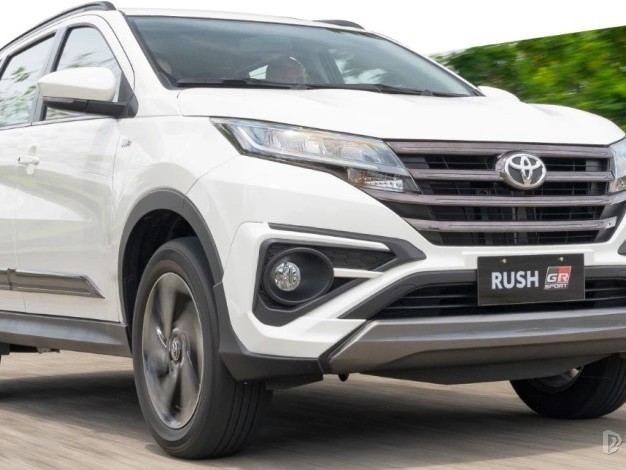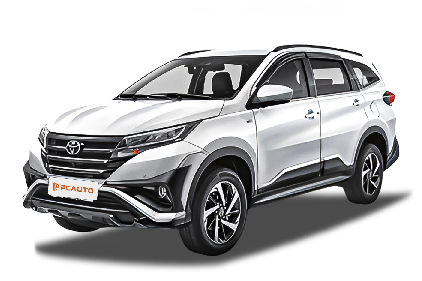Q
Does Toyota Rush feature 4x4?
No, the Toyota Rush is not a four-wheel drive (4x4) vehicle; it features a rear-wheel drive (RWD) system. This means that the engine's power is delivered to the rear wheels, offering distinct advantages. Rear-wheel drive vehicles typically provide better handling and balance under certain driving conditions, resulting in a more enjoyable driving experience.
For the Toyota Rush, the RWD configuration may contribute to a more stable ride, particularly when driving on paved roads. With a rear-wheel drive system, the vehicle can exhibit improved traction and acceleration performance. While it may not possess the off-road capabilities of a four-wheel drive vehicle, it nonetheless offers a reliable and efficient driving option for daily commuting and various road conditions. This car is particularly well-suited for those prioritizing a smooth driving experience on regular roads.
Special Disclaimer: This content is published by users and does not represent the views or position of PCauto.
Related Q&A
Q
Is Toyota Rush a Jeep?
The Toyota Rush is not a Jeep in the traditional sense, but rather a compact SUV built on the Toyota IMV platform, which leans more towards urban travel in the Malaysian market. This model features a higher ground clearance of approximately 220mm along with a robust and boxy exterior design, offering some light off-road capability. However, its primary focus remains on daily commuting and family use as a city-oriented SUV.
The Rush is equipped with front-wheel drive (with an optional four-wheel drive available in certain markets) and is powered by a 1.5L naturally aspirated engine (2NR-VE model) that delivers a maximum output of 104 PS. The vehicle's tuning prioritizes fuel efficiency over hard-core off-road performance. Compared to professional off-road vehicles like the Jeep Wrangler or Toyota's Land Cruiser series, the Rush lacks features such as part-time four-wheel drive and differential locks, but its compact size and nimble handling make it practical for various road conditions in Malaysia.
For users who occasionally need to tackle muddy or rocky terrain, opting for the four-wheel drive version and adding a skid plate is advisable. However, for serious off-roading, more specialized models are recommended.
Q
How many people can sit in a Toyota Rush?
The Toyota Rush can accommodate up to seven passengers. It features a 3+2+2 seating layout, which is a common configuration for seven-seater vehicles. This arrangement offers flexibility in passenger seating options. The middle row seats come with a 60:40 split-folding design, allowing for one-touch folding and manual adjustment of the incline angle, while the rear row utilizes a 50:50 split-folding design.
This versatility enables various seating configurations to cater to different needs, such as providing extra space for passengers or increasing cargo capacity. Whether you're traveling with family or friends, the seven-seat layout of the Toyota Rush offers a convenient option for group outings.
Q
Is a Toyota Rush AWD?
No, the Toyota Rush available in Malaysia is not an all-wheel drive (AWD) vehicle; it is equipped with a rear-wheel drive (RWD) system. This rear-wheel drive setup provides good balance and handling across various driving conditions. With its seven-seat layout, practical interior space, and decent off-road capability despite being RWD, the Toyota Rush has become a popular choice in the local SUV segment.
It comes with a range of safety features, including multiple airbags and electronic stability control, while the comfortable cabin layout enhances the overall driving experience. Its fuel-efficient gasoline engine and other convenient amenities cater to the needs of many local consumers.
Q
Is the Toyota Rush a CVT or automatic?
The Toyota Rush is equipped with an automatic transmission (AT), rather than a continuously variable transmission (CVT). The AT, which utilizes a hydraulic torque converter, connects to the engine and employs internal planetary gears to facilitate gear shifting and torque conversion. Both the 2019 Toyota Rush 1.5G AT and 1.5S AT feature this automatic transmission.
On the other hand, a CVT uses two variable-diameter pulleys and a steel belt to continuously and seamlessly adjust the gear ratio. The AT in the Toyota Rush offers automatic characteristics, allowing drivers to enjoy convenience without the need for manual shifting. This enhances the driving experience by making it more relaxed. Furthermore, the Rush's AT helps deliver the engine's power smoothly to the wheels, ensuring a comfortable ride. With its smooth shifting and reliable operation, the automatic transmission in the Toyota Rush meets the daily driving needs of many consumers.
Q
Is Toyota Rush expensive?
The price of the Toyota Rush ranges from RM 93,000 to RM 97,000, and whether this is considered expensive largely depends on individual perspectives and needs. For consumers on a tight budget who require a seven-seater vehicle, this price range may be quite reasonable, especially given the array of standard safety and practical features it offers, including six airbags, electronic stability control, and a 360-degree parking camera system.
From a segment perspective, this pricing is in line with the market positioning for a B-segment compact SUV. However, consumers seeking higher performance or luxury features may find it pricey, especially considering the engine produces a maximum output of 105 PS and that the majority of the seat adjustments are manual.
Q
What type of car is the Toyota Rush?
The Toyota Rush is classified as a B-segment vehicle. With a length of 4,435 mm, width of 1,695 mm, height of 1,705 mm and wheelbase of 2685mm, it features a five-door, seven-seat layout that is suitable for family use. The vehicle weighs between 1,300 and 1,305 kg, and has a fuel tank capacity of 45 liters.
Powering the Rush is a 1.5-liter gasoline engine that delivers a maximum output of 105 horsepower, paired with a rear-wheel-drive system and an automatic transmission (AT). The front suspension consists of MacPherson struts, and the braking system is equipped with ventilated disc brakes.
Safety features are extensive and include an anti-lock braking system (ABS), electronic stability control, and six airbags. Comfort features are well-appointed, with standard automatic climate control, a touchscreen infotainment system, and electric accessories. The seating configuration provides flexibility for both passengers and cargo.
Q
How fast can a Toyota Rush drive?
The Toyota Rush is powered by a naturally aspirated 1.5-liter four-cylinder gasoline engine, which produces 105 horsepower at 6,000 RPM and generates 140 Nm of torque at 4,200 RPM. It is paired with an automatic transmission and features a rear-wheel-drive layout.
While there is currently no official information regarding the Toyota Rush's top speed, considering its engine power, torque, and vehicle characteristics, it may achieve a maximum speed of approximately 160 to 180 km/h under ideal conditions. However, this is merely an estimate.
It is important to note that speeding is not only dangerous but also violates traffic regulations. The focus should be on maintaining a safe driving speed. Additionally, factors such as road conditions, vehicle load, and engine status can impact the actual attainable speed.
Q
What is the safety rating of Toyota Rush?
The Toyota Rush excels in safety features, offering a range of equipment designed to protect both drivers and passengers. Standard active safety systems include ABS (Anti-lock Braking System), Electronic Stability Control, Lane Departure Alert, Automatic Emergency Braking, and Forward Collision Warning, all of which work together to effectively prevent accidents.
In terms of passive safety, the vehicle is equipped with six airbags, including those for the driver, front passenger, front side airbags, and curtain airbags for both front and rear passengers, providing comprehensive protection for occupants. Additionally, the ISOFIX child seat anchors offer safety and convenience for families traveling with children.
While there is no specific safety rating data available, the rich and practical safety features of the Toyota Rush suggest a high level of protection for those inside the vehicle, offering driving safety on every journey.
Q
Can a Toyota Rush go uphill?
The Toyota Rush is capable of tackling inclines with ease. It is equipped with a 1.5-liter gasoline engine that delivers a maximum power output of 105 horsepower. Under normal conditions, this level of power is sufficient to propel the vehicle uphill. Additionally, features like rear-wheel drive provide enhanced traction and stability when ascending.
The vehicle also comes standard with a Hill Start Assist feature, which prevents rollback when starting on a slope, giving drivers added confidence during incline driving. With a ground clearance of 220 millimeters, the Rush is well-equipped to handle rugged terrain without the risk of wearing the bottom. With these capabilities, the Toyota Rush is well-prepared to navigate climbing scenarios effortlessly.
Q
Is a Toyota Rush a 7-seater layout?
Yes, the Toyota Rush is a 7-seater vehicle. It features a 3+2+2 seating configuration, comfortably accommodating seven passengers. This makes it a practical choice for families or groups in need of extra seating. Compared to smaller vehicles, its seven seats provide the flexibility to transport more people.
Whether for daily commutes, road trips, or carrying larger groups, the 7-seat configuration of the Toyota Rush offers convenience and practical functionalities. Additionally, the interior design and seating arrangement are crafted to ensure sound comfort for all passengers.
Latest Q&A
Q
What is the difference between the 2024 and 2025 BMW 5 Series?
There are some differences between the 2024 and 2025 BMW 5 Series models. In terms of pricing, the 2024 520i starts at RM 332,800, with the 520i M Sport variant coming in at RM 349,800. The 2025 530i M Sport, on the other hand, is priced at RM 399,800.
Under the hood, the 2024 520i engines deliver either 210PS or 208PS, while the 2025 530i M Sport ups the ante with a 258PS powerplant. Performance-wise, the 2024 models top out at 230km/h and sprint from 0-100km/h in 7.5 seconds. The 2025 model pushes that top speed to 250km/h and shaves the 0-100km/h time down to just 6.2 seconds.
Looking at the specs, some 2024 trims have rear seats with manual adjustments or fixed configurations, whereas the 2025 model gets a 40:20:40 split-folding rear seat setup. Audio systems also see an upgrade: most 2024 models feature Harman Kardon speakers, while the 2025 model steps up to a Bowers & Wilkins surround sound system.
Additionally, the 2025 5 Series hit dealerships on March 13, 2025, and comes with a 2-year unlimited mileage warranty. The 2024 models first arrived on September 2, 2024.
Q
How much is insurance for a 2024 BMW 5 Series?
The insurance cost for the 2024 BMW 5 Series in Malaysia varies based on several factors, typically ranging from RM5,000 to RM15,000 annually. The exact amount depends on the vehicle model (such as 520i, 530e, or M550i), engine displacement, the owner's age, driving record, type of policy (comprehensive or third-party), and the insurance company's discount policies. For instance, the high-performance M550i, with its higher repair costs, will have significantly higher premiums than the entry-level 520i, while the hybrid 530e may qualify for partial insurance discounts due to its eco-friendly features. Additionally, Malaysia's insurance market is influenced by the No Claim Discount (NCD), where drivers with consecutive claim-free years can enjoy a maximum 55% reduction in premiums. It's advisable to obtain accurate quotes through insurance company websites or comparison platforms before purchasing a car, and also to understand the additional services offered by Malaysian car insurance, such as roadside assistance or windscreen coverage, as these details can impact the final decision. Notably, luxury car insurance usually includes higher third-party liability coverage limits to comply with local regulatory requirements, and owners can also adjust the excess amount according to their needs to balance premium costs.
Q
What is the maintenance cost of a 2024 5 Series?
The maintenance costs for the 2024 BMW 5 Series in Malaysia can vary depending on the specific model and driving habits, but generally speaking, the regular servicing fees for the first 3 years of a new car are roughly between RM3,000 to RM5,000 per year. This depends on the chosen original maintenance package and the actual mileage driven. BMW offers various maintenance plan in Malaysia, allowing owners to opt for one-time payment or installment plans. These packages typically cover basic items like oil changes, filter replacements, and brake inspections. If the vehicle is equipped with more high-tech features, such as active suspension or a hybrid system, the long-term maintenance costs might be slightly higher. However, BMW's after-sales service network in Malaysia is quite comprehensive, with many authorized service centers capable of providing professional maintenance and repair services. To reduce long-term ownership costs, it's advisable for owners to follow the manufacturer's recommended regular maintenance schedule and use genuine parts. This not only extends the vehicle's lifespan but also helps maintain a good resale value. Additionally, given Malaysia's hot and humid climate, owners should pay extra attention to maintaining the air conditioning system and battery to ensure the vehicle always stays in optimal condition.
Q
How much is a used BMW 5 Series 2024?
In the current Malaysian market, used 2024 BMW 5 Series models aren't widely available yet due to the new car's relatively recent launch. However, based on the market trends for used BMW 5 Series of similar model years and conditions, prices typically range from RM250,000 to RM350,000. The exact price depends on factors like trim level, mileage, maintenance history, and whether the original factory warranty is still valid. For instance, higher-spec models like the 530i M Sport might be closer to the upper end of that range, while entry-level variants such as the 520i would be relatively lower. When buying a used car, it's advisable to go through officially certified pre-owned channels or reputable dealerships to ensure the vehicle has undergone rigorous inspection and comes with warranty coverage. Additionally, the BMW 5 Series is renowned for its luxurious interior, advanced technology, and driving dynamics – the 2024 model, in particular, likely features the updated iDrive system and mild-hybrid technology, which also influence used prices. In Malaysia, used car prices can also be affected by import duties, road tax, and insurance costs, so it's recommended to thoroughly assess the total cost of ownership and compare different car sources to get the best value for money before making a purchase.
Q
How many BMW 5 Series sold in 2024?
As of 2024, official sales figures for the BMW 5 Series in Malaysia haven't been formally released yet. But looking at BMW Malaysia's past market performance and industry trends, this luxury sedan has always maintained steady demand locally, especially thanks to its blend of sporty performance and business luxury that really resonates with local buyers. For 2024, the BMW 5 Series has rolled out more eco-friendly powertrain options, like plug-in hybrid models, which should further appeal to buyers who want both efficiency and high performance. In the Malaysian market, luxury car sales are usually influenced by the economic environment, consumption tax policies, and brand promotional activities. Interested consumers are advised to follow BMW Malaysia's official website or authorized dealers for the latest and most accurate information. Additionally, as a representative of mid-size luxury sedans, the BMW 5 Series competes with models like the Mercedes-Benz E-Class and Audi A6, which also have a strong presence in the Malaysian market. Consumers can make a comprehensive comparison based on personal preferences and budget.
View MoreRelated News

The compact SUV Toyota Rush, which has already been discontinued in Malaysia, does anyone around you drive it?
AshleyJul 25, 2024

Toyota Leads Global Sales in 2023, Despite 8% Decline but Tops Thailand
Kevin WongFeb 23, 2024

Why are people more willing to choose Toyota Hilux instead of Isuzu D-Max?
JamesNov 3, 2025

In Malaysia, which sliding door MPVs are available?
MichaelOct 30, 2025

Toyota Land Cruiser FJ did not disappoint, the most anticipated civilian off-road vehicle is back.
Kevin WongOct 21, 2025
View More


















Pros
Cons